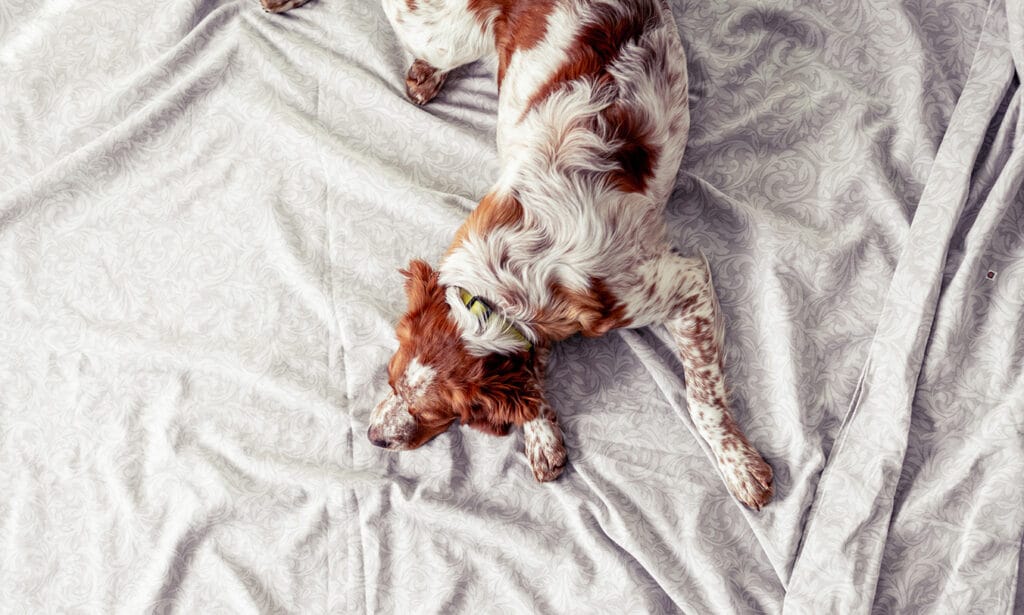You may have an inkling that you have fleas in your bed if you notice bug bites on yourself, and with good reason: Little parasites tend to bite exposed skin areas while you sleep, and can cause nasty, painful, itchy, circular red bite marks on human skin, according to Douglas Mader, MS, DVM, DABVP (C/F, R/A), DECZM, a veterinarian in the Florida Keys. But, bug bites can be caused by a lot of different things, and even if you do have a flea infestation in your bed, it’s not an impossible task to get rid of them.
Vets help us identify the signs that you’ve got fleas in bed—and share how to handle the scene if you do have them (sorry!).
In This Guide:
Flea Bite or Bedbug Bite?
You suspect you’ve got some kind of insect sitch going on in your bed—but are we dealing with fleas or bedbugs here? We never thought we’d utter these words, but you should probably cross your fingers and hope for a flea problem. Dr. Mader says it’s almost impossible to eliminate bedbugs from your home without a professional exterminator—plus you’ll have to basically soak everything you own in hot water—whereas fleas can be dealt with in a more DIY fashion if the infestation is not too advanced. (More on this below.)
So how do we establish the difference and suss out what we’re dealing with so we can treat effectively? According to Nicole Savageau, VMD, an Austin, Texas–based veterinarian with The Vets, we need to take a closer look at the bites:
Appear as small, red, itchy welts in a line or cluster
Are smaller and more random in arrangement, often appearing as tiny red bumps surrounded by a reddened halo
Are slightly larger than flea bites and may have a darker red center
Are smaller, with a more pronounced redness around the puncture site
Feel more like a slight prick or burning sensation initially
Are often described as intensely itchy from the moment of the bite
Check Your Pet’s Skin and Coat for Fleas
You’ve got the telltale flea bites on your body and are pretty sure you don’t have bedbugs. The next step is to check your furry friends for wee beasties because, chances are, if they’ve got ’em, you’ve got ’em.
According to our vets, this is how to tell if your dog or cat has fleas:
- Appearance of small, fast-moving insects on their skin or coat that are usually dark brown, reddish-brown or almost black in color
- Observance of scurrying insects through their fur or near the base of the tail
Adult fleas are about one-eighth of an inch long and have laterally flattened (very thin from side to side) bodies, Dr. Mader says, making them very difficult to squash.
5 Signs You’ve Got Fleas in Bed
OK, so you’ve examined your bites—and your pet’s coat—and have more than a sneaking suspicion that you have fleas. Let’s dig a little deeper and look for some more signs that you do indeed have fleas in your bed.
The following are signs of fleas in bed, according to Dr. Mader and Dr. Savageau:
- Flea dirt: Flea dirt is pretty much the nice way of saying “flea feces.” This can look like regular dirt, ground pepper or specks of sand—and if it turns reddish-brown when you wet it on a paper towel … yup, that’s flea poop.
- Itchy bites on your body resembling small red bumps: We’ve already covered bites above, but this bears repeating: Rashes and itchy bites that appear as random small bumps with pronounced redness are a red flag that you have fleas.
- Flea eggs on bedsheets: Flea eggs are very small (typically about 0.5 millimeters in length), oval-shaped and have a soft shell called a chorion that is off-white in color. They may be found scattered on bedding and appear like grains of salt. Fleas love to lay eggs in your bed, so this might be the most common thing to look for.
- Flea larvae on bed: These are tiny, wormlike creatures with a whitish color and can also be found in bedding that is infested with fleas.
- Adult fleas: You may see small, black bugs under your covers. But if you blink you might miss fleas on bedding! They can jump fast and far, so it’s not uncommon for them to be overlooked.
If you see any of the above, don’t fly into a flea-ridden panic quite yet! With proper steps, we can get rid of the infestation.
How To Get Rid of Fleas in Your Bed
While professional pest control services may be necessary for severe infestations, according to Dr. Savageau, many flea situations can be treated without the help of a pest control or an exterminator.
When dealing with fleas in your bedding, Dr. Mader points out that you need to treat not only your bed, but the whole house. He and Dr. Savageau recommend the following steps:
- Start with your pet. Because your furry friend is likely where we boarded this whole rocket ship to the moon, it’s best to get to the root of the matter and treat them first. You can start with a flea comb, like the Hartz flea comb, then move on to a good shampoo, like Adams Plus flea and tick shampoo. For more, read our in-depth guide on how to rid your pet of fleas.
- Treat the carpets and furniture in every room. Reach for an indoor treatment, like Black Flag flea and tick home treatment, to break the life cycle of fleas and kill fleas, flea eggs and flea larvae in infested carpets, upholstery, rugs, baseboards and moldings. Wipe down the crevices of your bed frame as well, as critters love to hide in this area.
- Wash bedding in hot water. Use hot, soapy water and dry everything on the highest heat setting after the wash. Fleas will die in temperatures over 100 degrees Fahrenheit. Wash all blankets, stuffed toys and pet bedding too.
- Vacuum the mattress and surrounding areas. This includes under the bed and every room in the house. Because vacuuming won’t kill adult fleas, be sure to clean out the vacuum bag (or switch out for a new one) when you are done—and dispose of it in the outdoor trash! You can also give everything a good shake of flea killing carpet powder, for good measure. A good steam cleaning doesn’t hurt, either.
- Treat the yard and surrounding areas. PetArmor home and yard treatment provides up to 2,000 square feet of outdoor flea-killing coverage.
Dr. Mader reminds you to consult your vet for both at-home professional strength products and an insecticide that will work well and are safe for your pet when DIYing a flea extermination.
How To Prevent Fleas in Bed
The best offense is a good defense, so getting ahead of the game and preventing fleas and bedbugs in the first place is really the move—especially if you have pets who like to get up in your bed.
To stay ahead of the game, Dr. Mader and Dr. Savageau suggest:
- Washing bedding frequently: Remember that fleas die at temperatures over 100 degrees Fahrenheit, so a good wash and dry is a great preventive.
- Vacuuming carpets and upholstery regularly: Vacuuming is a great way to pick up fleas in the home to help break their life cycle. Just remember to clean the canister or remove the vacuum bag from your house promptly.
- Sealing cracks and crevices: Keeping your home sealed up tight helps keep unwanted guests out.
- Inspecting secondhand furniture before bringing it into your home: There might be a good reason someone is getting rid of that old couch!
- Using flea prevention products regularly: Your vet will recommend the best flea preventive for your dog or cat.
More about fleas and pets:
Share:














